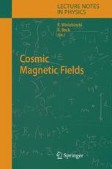Search
Search Results
-
Magnetic Fields in Galaxies
Magnetic fields are a major agent in the interstellar medium. They contribute significantly to the total pressure which balances the gas disk against...
-
Magnetic Fields in Galaxy Systems, Clusters and Beyond
The discovery of significant magnetic fields beyond our Milky Way was unwittingly made in the early 1950’s when new “discrete” cosmic radio sources...
-
Stellar Magnetic Fields
Stellar magnetic fields are directly detected or inferred across the whole Hertzsprung--Russell Diagram. Attention in this chapter is concentrated on...
-
Magnetic Fields in Diffuse HI and Molecular Clouds
The diffuse interstellar HI is the matrix within which many molecular clouds reside and the medium that soaks up the energy injected by sources such...
-
Magnetic Fields in the Early Universe
A substantial magnetic field could conceivably have been generated in the ultra-early Universe. However, the relevant physics at those eras is very...
-
Boundary Conditions
Most Numerical Relativity simulations are devised to approximate the time evolution of the dynamical fields starting from data given on an initial...
-
The Four–Dimensional Spacetime
Physics theories are made by building mathematical models that correspond to physical systems. General Relativity, the physical theory of...
-
Mesoscale Magnetic Structures in Spiral Galaxies
Virtually all spiral galaxies host magnetic fields ordered at scales comparable to the galactic size (Beck et al., 1996; Beck, 2000, 2001)....
-
Magnetic Fields in the Milky Way, Derived from Radio Continuum Observations and Faraday Rotation Studies
Magnetic fields are found everywhere in our Universe. We know that our Earth possesses a dipolar magnetic field. Magnetic fields have been observed...
-

-
Black Hole Simulations
The simplest Black Hole initial data can be obtained from the Schwarzschild line element. The “Schwarzschild coordinates” expression (1.54), can be...
-
The Evolution Formalism
The general covariant approach to General Relativity is not adapted to our experience from everyday life. The most intuitive concept is not that of...
-
First Order Hyperbolic Systems
From the mathematical point of view, the mixed-type systems (first order in time, second order in space) that we have considered in the previous...
-
Free Evolution
As we mentioned in the previous chapter, the “free evolution” approach is by far the most commonly used today in Numerical Relativity codes. It...
-
Importance of Magnetic Helicity in Dynamos
Magnetic helicity is nearly conserved and its evolution equation provides a dynamical feedback on the alpha effect that is distinct from the...
-
The Origin of Galactic Magnetic Fields
In 1949 Hiltner (1949) and Hall (1949) independently discovered the large-scale magnetic field embedded in the interstellar medium. Actually, they...
-
Numerical Magnetohydrodynamics in Astrophysics
Newtonian magnetohydrodynamics (MHD) is a very special limit of Maxwell’s equations and plasma dynamics. In the last 10 years, powerful numerical...
-

-
Signatures of convection in the atmospheres of cool evolved stars
Evolved cool stars of various masses are major cosmic engines, delivering substantial mechanical and radiative feedback to the interstellar medium...

-
Turbulence modelling in neutron star merger simulations
Observations of neutron star mergers have the potential to unveil detailed physics of matter and gravity in regimes inaccessible by other...

